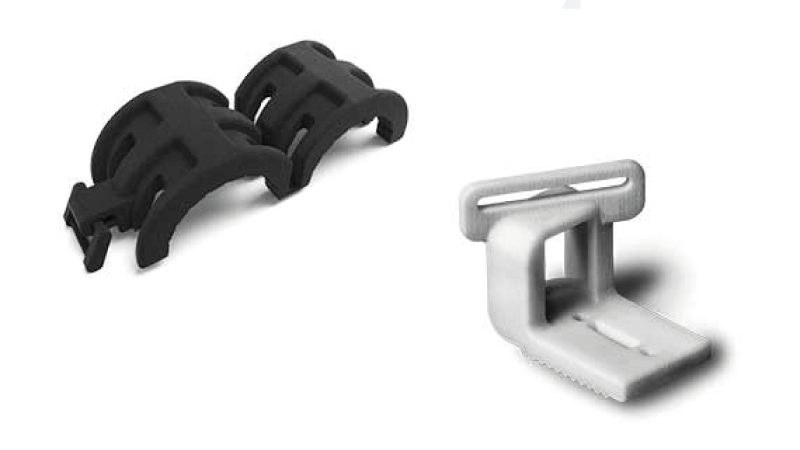MJF vs SLS 3D printing - A head-to-head comparison
New 3D printing technology Multi Jet Fusion (MJF) may appear to be a replacement for selective laser sintering (SLS) after all both build parts from thermoplastic nylon but MJF is faster, more precise and produces more consistent mechanical properties throughout the part.

Multi Jet Fusion parts (left) will typically have improved surface finishes and mechanical properties compared to SLS parts (right).
At first glance the relatively new 3D printing technology Multi Jet Fusion (MJF) may appear to be a replacement for selective laser sintering (SLS) after all both build parts from thermoplastic nylon but MJF is faster, more precise and produces more consistent mechanical properties throughout the part. But don’t ditch SLS just yet it still has some advantages over this new kid on the block, it all depends on what you need your part for.
Building 3D parts
Both processes build parts by thermally fusing, or sintering, polymer powder particles one layer at a time and both use thermoplastic polymers which are usually nylon. The difference is that SLS uses a laser to scan and sinter each cross section, while with MJF ink is dispensed onto the powder as a fusing agent to promote the absorption of infra-red light which fuses these inked layers.
Both produce durable parts for functional testing and end use.
How do they compare?
Cost. One big difference is that MJF is faster so its manufacturing costs tend to be lower.
Cost is important but it is not the only thing to consider you also need to think about feature resolution, surface finish, materials, colours and mechanical properties.
Feature resolution. Using MJF you can produce smaller features right down to 0.5mm. SLS in comparison comes in with features between 0.75 to 1.0mm depending on which material you use. Sadly it’s not quite that simple though because although you can have smaller features with MJF, SLS is better for smaller feature accuracy.
Surface finish. In theory MJF edges this, but both technologies produce parts with a grainy texture so you will need to consider some post processing for both.
Materials. The main material for both is nylon, but SLS does offer you more options such as carbon filled PA and glass filled PA which give additional mechanical properties. But watch this space as far as material selection is concerned because things change rapidly in the 3D printing world. Until recently SLS could produce these and MJF could not, but now you can get parts from this great material using MJF as well.
Colour. Here the clear winner is SLS since you can die SLS parts to almost any colour that you want. It’s more limited with MJF because the fusing agent used is black since dark materials tend to absorb infrared radiation better. It means MJF parts have a light grey appearance, which your supplier can dye to black for cosmetic reasons if needed.
Mechanical properties. Again at first glance you would think that MJF wins this one because the way that it builds parts means that you tend to get more consistent mechanical properties along all directions of its geometry. If you have key features on multiple surfaces then MJF may be the better option.
But don’t forget that SLS offers you more materials – all of which have different mechanical properties – so you will need to delve a bit further and decide what mechanical properties are important for your part.
Size of part. Here you will need to check what dimensions your supplier can provide. Generally SLS can produce bigger parts.
At Protolabs the maximum size for SLS is 676mm x 367mm x 564mm. This compares to a maximum size for MJF parts of 284mm x 380mm x 380mm and we actually recommend maximum dimensions of 200mm x 200mm x 200mm to avoid warping and dimensional inaccuracy.
Number of parts you need. If you need more parts then MJF is faster so it can produce more parts in a shorter time period so delivery will be faster.
Ultimately both SLS and MJF are great for producing functional parts with good dimensional accuracy in pretty much any geometry that you want. Which one you choose will depend on what you need from your part.
For questions on any of our services at Protolabs, please contact an applications engineer at customerservice@protolabs.co.uk or +44 (0) 1952 683047. Have a design ready for 3D printing? Upload it now for an instant quote.